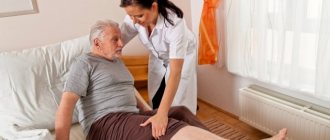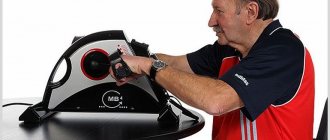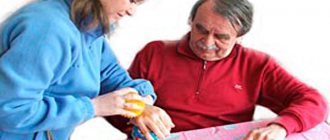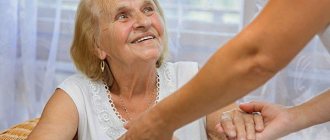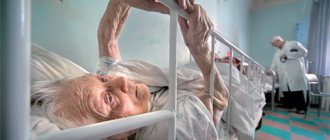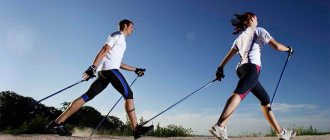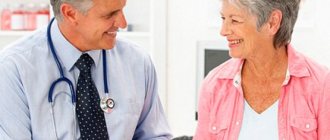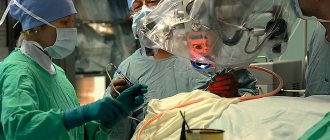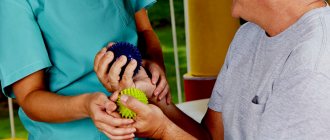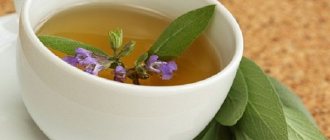Victoria Popova
Cardiologist
Higher education:
Cardiologist
Saratov State Medical University named after. IN AND. Razumovsky (SSMU, media) Level of education - Specialist 1990-1996
Additional education:
“Emergency Cardiology”
1990 - Ryazan Medical Institute named after Academician I.P. Pavlova
Contacts
Caring for a patient after a stroke is a complex task. Relatives will have to face strict rules, since without appealing to them they will not be able to get the person back on his feet. Experts give useful advice, suggesting how to cope with the consequences of a serious illness, as well as clarify how to avoid complications. You need to try in practice to perform all the necessary actions to bring a person back to life.
Consequences of a stroke
Cerebral circulation disorders often lead to serious consequences. Among them are motor dysfunctions. A person loses the ability to move independently, cannot hold objects in his hands or take them.
Paresis and paralysis are observed. When it is possible to make movements, it is often discovered that it is impossible to coordinate them and maintain balance. This happens when walking, trying to sit down, or changing body position.
Sensitivity disorders are noted. The victim loses the ability to feel pain and temperature changes. There is a feeling of numbness, burning, crawling. The limbs become as if they were made of cotton.
In difficult cases, a disorder of spatial and temporal orientation is possible.
With damage to the cerebral hemispheres or an extensive stroke, memory deterioration, loss of the ability to perform logical operations, and a decrease in cognitive abilities are noted.
For reference. Circulatory disorders affecting the speech centers lead to loss of speech functions, loss of the ability to express one’s thoughts, choose the right words, construct phrases, and understand spoken speech and written words.
A stroke often leads to a deterioration in psycho-emotional state. Depression, apathy, and lack of self-confidence develop. Many become aggressive, hot-tempered, and capricious.
Main objectives of rehabilitation
The goal of caring for a patient with a stroke is to improve his quality of life, stabilize his condition, and improve his well-being. With mild and moderate lesions, proper care and the patient’s desire for recovery can help him recover almost completely.
In case of severe pathologies, care will allow to achieve a partial return of lost functions, prolong life, and avoid complications in the form of dangerous diseases.
To achieve these goals, relatives of a stroke victim face several main tasks:
- prevention of bedsores;
- maintaining hygiene;
- safety;
- restoration of lost functions;
- catering;
- prevention of pneumonia;
- prevention of thrombosis;
- exclusion of relapses.
For reference. It is easy to define tasks, but difficult to carry them out, especially when it comes to loved ones.
Improving their well-being requires regular, daily work. It is associated with a high risk of emotional burnout, loss of self-confidence, significant restrictions in personal life, narrowing of interests, and negative emotions.
Preventing bedsores
For reference. One of the common complications that a bedridden person faces after a stroke is bedsores. These are areas of soft tissue necrosis that occur in areas of increased pressure during a prolonged immobile position of the body.
The main reason is insufficient blood supply. It is believed that for a bedsore to occur, it is enough for the blood flow to be disrupted for just two hours.
Bedsores occur on the sacrum, coccyx, heels, shoulder blades, knees, elbows, back of the head, and outer thighs.
Attention! The consequences of even small wounds are sepsis, blood poisoning, death.
To prevent bedsores, rubber circles are used. They are placed under those areas of the body that experience the greatest pressure.
It is recommended to change the position of a stroke victim every two hours. Massages are provided regularly and accessible physical exercises are performed.
Every day the patient's body is checked for pressure sores. Twice a day, the areas where damage appears are washed. The skin is treated with alcohol solutions and talc.
Bed linen should be changed regularly. After each meal and movement of the patient, folds are smoothed out and crumbs are removed.
Maintaining Hygiene
One of the key tasks of home stroke care is ensuring hygiene of the body as well as the room in which it is located. Dirt and sewage lead to bedsores and the spread of infections.
Hygiene procedures should include:
- Sanitation of the oral cavity. At least once a day, clean the tongue and mucous membranes with a napkin.
- Washing. Twice a day, and if necessary more often, wash the face with warm water, clean the eyes, ears, and treat the nose.
- Body cleansing. Wipe the entire surface with a napkin or cloth soaked in soapy water, rinse with clean water, and dry.
- Washing the perineum. Each time after removing the diaper, you need to completely clean and wash the perineum, the area around the anus, and dry it. The diaper is changed at least 2 times a day.
- Taking a bath. Once a week it is recommended to take a shower or bath to cleanse your hair. To wash your hair, use special inflatable baths.
- Ensuring bed cleanliness. Linen must be changed regularly. Smooth the sheets several times a day. To replace them and remove crumbs, turn the immobilized person on his side and place a cloth under him. Then they return it to their back and turn to the other side. Straighten the sheet.
Rules for care after a stroke at home
Is it possible to care for a sick person independently? Maybe. But it is difficult not to develop exhaustion of the nervous system from overload, especially if he is in severe paralysis. The best solution is the help of a nurse in this case. If you care about yourself. How to care for a grandparent after a stroke if it is not possible to provide professional care? It is easiest to organize care at home if the patient is in relatively normal condition, without complete paralysis of the body. In this situation, care comes down to monitoring the intake of medications and compliance with procedures prescribed by specialists. And moral support for your loved one, because now it’s even harder for him than usual. If procedures are prescribed, you can go to the hospital. Changing your location and communicating with additional people will always be useful. Especially the elderly. Sharing your experiences with those who are close in spirit is healing for every person.
Function restoration
For reference. As part of the care for stroke survivors, everything must be done to ensure the return of lost skills.
To normalize motor activity, massage and exercises are done every day. Passive gymnastics is performed with paralyzed people. Anyone who has the ability to move should be encouraged to pull themselves up, sit down, stand up, and learn to walk again.
It is important to promote learning self-care skills. Those who have suffered from the disease are taught again to hold a spoon, eat, comb their hair, wash their face, and get dressed.
They talk to the patient every day, let him listen to music, radio, and read. This helps restore speech and at the same time keeps the person's brain in a state of constant reception and processing of information.
To improve memory and restore logical abilities, they give exercises to develop mental activity, counting, memorizing, and play.
Often, patients experience narrowed emotions, depression, and apathy. Communication and constant work with them allows you to restore self-confidence and feel the joy of small victories.
The ability to communicate with other people plays an important role. Sanatorium-resort treatment and visits to rehabilitation centers help with this. Partially immobilized people are shown walking outside in strollers, with canes or other devices.
Pneumonia Prevention
Attention. One of the pathologies that affects a bedridden person is pneumonia. It develops due to stagnation and impaired blood drainage in the lungs. Once the disease has begun to develop, it is difficult to cure. There is a good chance that a stroke survivor will not be able to overcome pneumonia.
To prevent the development of the disease, vibration massage is regularly performed, and medications are prescribed to facilitate the removal of mucus. The patient is advised to perform exercises to develop breathing.
Catering
When caring for people affected by a stroke at home, much attention is paid to nutrition and the digestive process.
The menu should not be the same; it should include antioxidants, essential minerals, and vitamins. In addition to the benefits, the wishes of the victim must be taken into account. Favorite dishes will brighten up difficult days after illness.
The basic principles of nutrition are:
- Limiting baked goods, animal fats, smoked and spicy foods on the menu.
- Refusal of alcoholic drinks.
- Inclusion of lean fish, meat, dairy products, cereals, berries, vegetables.
- All dishes must be boiled, stewed, steamed.
- If swallowing and chewing are impaired, food is served in liquid form or puree.
- In the absence of contraindications, it is recommended to drink up to 2 liters of water per day.
For reference. It is advisable for the person to sit while feeding. At the same time, pillows are placed around for support.
Restoration activities
Turning a bedridden patient after a stroke is necessary for medical, hygienic care, feeding and massage. It is important that the patient’s position on the bed is not static and does not cause him discomfort or pain.
All paralyzed parts of the body should take a natural position, and the process of bending the limbs should alternate with periods of relaxation. Such “passive” exercises will help maintain joint mobility in immobilized limbs.
To create a gap between the body and limbs, dense cushions and small pillows are used, which not only fix the patient’s position, but also improve blood flow, preventing the appearance of prickly heat.
All recommendations on how to care for a bedridden patient after a stroke at home are given by the attending physician based on the severity of the patient’s condition and the type of impairment.
- improve muscle tone;
- normalize the blood circulation process;
- improve the functioning of internal organs;
- prevent limb contracture.
Simple movements of flexion, extension, rotation of the arms and legs, warming up the fingers, hands, and feet are performed after the acute phase of the disease, when the patient tries to sit or stand independently. Exercise therapy must be supplemented with breathing exercises and restorative massage.
The main condition for therapeutic exercises is regularity and a gradual increase in load. Exercises started in the first 2-3 months after a stroke help achieve good results.
Household organization
The general requirements for the room in which the patient is located are: cleanliness, fresh air, and the absence of unnecessary objects that block the approach to the bed and make it difficult to care for a stroke patient.
| Violation | Damage area | Action |
| Left-sided paralysis | The right side of the brain is affected: impaired motor functions, perception, coordination of movements, partial paralysis of the left side of the body. | All items in the room necessary for the patient and his care are located to the right of the bed. The patient must be re-taught to speak, explain letters, and show how they are written. |
| Right-sided paralysis | The left hemisphere is affected: impaired speech, memory, perception of information, emotional passivity. | The conversation uses simple words, tactile touches, facial expressions and gestures. It is advisable to touch upon pleasant, familiar topics and use written communication. |
The effectiveness of all rehabilitation measures directly depends on the emotional state of the bedridden patient. Round-the-clock care should include active communication with the bedridden family member and a patient attitude towards his fears, grievances and irritability.
Prevention of thrombosis
Due to physical inactivity and lying in one position for a long time, paralyzed people have an increased risk of venous blood stagnation in the lower extremities and thrombosis. Clots move easily and, bypassing large highways, can cause blockage of small vessels.
For reference. For these reasons, the risk of cerebral ischemia and pulmonary embolism increases.
For the purpose of prevention, regular exercise, wearing compression stockings or bandaging the legs with elastic bandages is recommended. Drug therapy associated with taking blood thinning pills is being carried out.
Relapse Prevention
A stroke survivor has a significantly increased likelihood of developing another stroke. To avoid the risk of a repeat incident, high-quality care, physical activity, compliance with the recommendations of the attending physician, massage, the use of physiotherapy methods, and visits to specialists will help.
For reference. Blood pressure and pulse are checked twice a day. If normal levels increase, seek help from a doctor.
An important role is played by the patient’s psychological comfort, absence of stress, heavy loads, and optimism.
In any situation, a stroke survivor must give up bad habits and follow the principles of a healthy diet.
Family support
If there is a patient nearby, all attention is usually concentrated on him.
Attention. However, there will be no proper care, attention, speedy recovery of the patient, or incentive for rehabilitation if the people caring for him themselves plunge into the abyss of depression.
Too much physical and psychological stress leads to caregivers lashing out at the patient, relatives, and friends. They lose the desire to engage in care, which still does not help. They lose the ability to force themselves to work day after day without days off.
However, a stroke is a disease in which any retreat quickly leads to regression of what has been achieved and the inability to achieve recovery. In this regard, there are several recommendations for relatives of patients after a stroke, which will allow them to pull themselves together and fight to the end:
- Don't feel sorry for yourself. There are many people in the world in worse situations. It is better to think about the patient, control your emotions, use modern medicine and fight.
- Fatigue is normal. From time to time you need to give yourself a break. To do this, you can involve relatives, caregivers, and volunteers in the care. It is advisable to find time for walks and hobbies.
- The right to negative emotions. Anger, aggression, disappointment, depression are normal aspects of mental life. They should not be thrown out on relatives and the patient. It’s better to box a punching bag, go for a run, take a walk, or just go out for a while until the outburst of anger passes.
- Requests for help. Asking for support in the situation of caring for a seriously ill person is not shameful and normal. This must be done openly, without hints or embarrassment.
- Contacting specialists. Currently, there are rehabilitation centers where patients can be left for a certain period of time. This will allow the caregiver to rest, and the patient will receive additional professional treatment.
- Communication. You need to constantly communicate with a stroke victim. This will make you feel better and help restore speech, contacts, and intimacy.
- Your own health. This is an important factor and cannot be ignored.
For reference. Stroke survivors are often cared for by their close relatives. They have to learn a new life, study the features of preventing diseases, performing procedures related to feeding and washing the sick.
The need for daily care is exhausting, causes emotional burnout, makes you feel tired, and deprives you of a free life. To increase the chances of recovery for the patient and maintain your own health, you need to pull yourself together, find time for rest, personal life, and continue to care for the victim.
source
What you need to buy
Caring for a patient after a stroke is greatly facilitated by modern equipment. Manufacturers of medical equipment offer a wide selection of products that are designed to care for bedridden patients. Some products have a high price, you can rent them or look for used models for sale.
One of the necessary items at home, where a patient is recovering from a stroke, is a special functional bed. It is a metal structure consisting of two or three moving sections. Each section can be lowered or raised, changing the position of the patient's body. This eliminates the need to move a person on his own when he wants to sit or lie down.
Buying a functional bed can be very expensive, but it makes caring for a bedridden patient after a stroke much easier. The models are also equipped with handrails that will prevent a person from falling. In addition, a special device on top allows a person to sit or rise independently using his hands. With a temporary loss of mobility, even a small amount of independent action has a positive psychological effect.
There are other tools to help care for patients who have had a stroke:
- Bactericidal emitter. Used to disinfect indoor air. Thanks to the protective housing and structure, the emitters can be used in the presence of people.
- Anti-decubitus mattress. The special design of medical mattresses is designed in such a way that a bedridden patient does not develop bedsores on the body.
- Diapers for adults. Very often, doctors note urinary incontinence in patients after a stroke. This is due to the fact that necrosis of brain cells and tissue affects muscle tone. Some sphincters in the body may not function properly.
- Bath for washing hair in bed while lying down. The compact device facilitates hygienic care for bedridden patients.
- Walkers. The device may be needed to restore motor functions.
- Toilet chair on wheels. A special toilet allows the patient to sit independently, thanks to supporting handrails, and does not need to use diapers.
Recovery and rehabilitation after a stroke at home
A stroke, or acute cerebrovascular accident, regardless of its form, is a serious disease. Due to a stroke, the functioning of various parts of the brain is disrupted. This means that a person is unable to carry out his usual activities.
Fortunately, a stroke is not a death sentence. In most cases, lost brain function can be restored, either completely or partially. And the rehabilitation program can be completed at home.
Possible complications from a sedentary lifestyle and their prevention
Caring for a patient after a stroke at home is impossible if the patient shows signs of complications (for example, fever, sudden contraction of intercostal muscles, intermittent breathing, which may indicate the development of pneumonia), swelling, bedsores, secondary diseases.
In the hospital, nurses care for patients after a stroke under the supervision of the attending physician. The nursing process - scientifically based patient care algorithms - ensures high efficiency of rehabilitation.
Treatment
A stroke is caused by blockage (ischemic stroke) or disruption of the integrity (hemorrhagic stroke) of blood vessels in the brain. As a result, blood circulation in the brain suffers, and nerve cells die due to lack of oxygen. Thus, due to a stroke, a person’s brain is deprived of some part of it that is responsible for certain functions - speech, intelligence, memory, sensitivity, vision, hearing, movement, and the fulfillment of natural needs (eating, urination and defecation).
A type of stroke is a transient ischemic attack, in which the symptoms of circulatory problems in the brain disappear after some time. However, it also requires careful attention and examination by a neurologist, since it can often transform into a full-fledged stroke.
Treatment of stroke is a multifaceted endeavor. If an acute cerebrovascular accident is suspected, the patient is immediately hospitalized. If the diagnosis is confirmed in the hospital, treatment of the patient begins. Conservative methods are usually used for this purpose. However, in some cases, surgery is necessary.
At first, treatment can only be carried out in a hospital. However, after the patient’s condition has stabilized and his life is no longer in danger, he is discharged. And further treatment should be carried out at home, but under the supervision of a neurologist.
The following methods are used in the treatment of stroke:
- taking medications,
- psychotherapy,
- proper organization of the patient’s life,
- physiotherapeutic procedures,
- diet,
- physiotherapy.
Treatment in the post-stroke period is also aimed at reducing the likelihood of relapse of the disease. It is no secret that many people who have had a stroke experience a relapse during the first and second year after the event. The probability of this event is approximately 10%. And repeated strokes can often be fatal.
The recovery period is divided into three stages:
- early – up to 6 months,
- late – 6-12 months,
- residual – more than a year.
The sooner work begins to restore brain functions damaged by a stroke, the greater the chances of success. In addition, activities must be systematic. You cannot give up and abandon the rehabilitation program halfway.
It is also worth remembering that a stroke does not appear just like that. Usually it is a consequence of some systemic disease or several at once:
However, most often strokes occur against the background of excessive alcohol consumption and smoking. It is no exaggeration to say that nicotine and alcohol literally destroy the blood vessels of the brain. You should not discount risk factors such as excessive physical activity, stress, working in harsh conditions, and poor nutrition.
Therefore, simultaneously with treating the consequences of the stroke itself, it is necessary to treat the disease that caused it. And after successful rehabilitation, the patient should permanently change his lifestyle, if it was he who led to the stroke.
There is a bedridden patient in the house: how to organize conditions and care for him
Complete or partial immobility after a stroke leads to the fact that a bedridden patient completely loses the ability to independently eat, go to the toilet, and maintain personal hygiene. Therefore, he needs constant help from loved ones and proper organization of care. The development of complications significantly aggravates the neurological status and can cause death.
Caring for a bedridden patient after a stroke
Immobility after a stroke is a consequence of severe disturbances in movements, their coordination, the possibility of purposeful actions, and decreased consciousness. This condition is accompanied by special requirements for maintaining vital functions.
Nutrition
Difficulty in feeding a patient after an acute cerebrovascular accident is associated with many negative factors:
- difficulty swallowing and chewing food;
- frequent choking;
- violation of taste determination;
- decreased sensitivity of the oral cavity;
- apathy, depression with loss of appetite.
In order to maximally provide the patient’s body with vitamins and microelements that contribute to recovery, it is necessary to prepare easily digestible dishes that do not require effort when taking them. For this, vegetable and fruit purees, mousses, first courses and porridges with a puree consistency, minced meat and fish, cottage cheese, and fermented milk drinks are recommended .
The main condition is that the food should be exclusively fresh, preference should be given to natural products, without preservatives or dyes.
Portions should be small, no more than 200 g at a time, the frequency of their intake is 6 - 7 times a day . Slow feeding is recommended and can take about 30 - 40 minutes. It is forbidden to rush the patient, as this poses a risk of food entering the respiratory tract. The position can be semi-sitting with pillows or on the healthy side.
For semi-liquid food, it is convenient to use cocktail straws (bent) or children's sippy cups, cups with a spout, as for drinking mineral water.
If the patient is able to eat from a spoon, then it is optimal to take a dessert spoon and fill it not completely, while making sure that there are no previous portions in the mouth. You should always feed from the healthy side.
Water should not be taken with food, it overloads the stomach and can cause a gag reflex. Therefore, they usually suggest drinking half an hour before a meal or an hour after.
The same applies to sweet drinks, desserts, and fruit juices.
We recommend reading the article about rehabilitation after a stroke at home. From it you will learn about recovery periods, exercises for rehabilitation after ischemic and hemorrhagic stroke, as well as exercise equipment for recovery.
Read more about nutrition after a stroke here.
Bathing
Every day the patient's body should be wiped with a sponge or terry cloth soaked in warm water. It is important that this happens consistently, especially in cool weather, to prevent hypothermia.
Therefore, for example, first the surface of the leg is treated, it is completely dried, and then they move on to the second. To protect the sheets from getting wet, when swimming, you need to put a medical oilcloth and a towel or diaper on it.
Every day the patient's body should be wiped with a sponge or terry cloth soaked in warm water.
A vessel is used for washing.
Be sure to wash the genitals with soap for intimate hygiene, dry thoroughly, ventilate, and powder with talcum powder.
If there are signs of redness or irritation of the mucous membranes and skin of the perineum, then after washing off the soap, use a weak (barely pink) solution of potassium permanganate or furatsilin (one tablet per 300 ml of water).
Organization of the place
A bedridden patient can spend more than one month in bed, and sometimes even a year.
It must be taken into account that the nervous system in such patients is damaged, the emotional background is disturbed, and intolerance to temperature changes, bright light and loud sounds is noted.
However, their complete absence is also undesirable. The room must be kept clean and ventilated at least 4-5 times a day for 10-15 minutes.
Next to the bed there is a table for care items and medicines. Within the patient's reach, it is imperative to place everything he may need - water, napkins, a telephone or bell, an electric bell in order to call the caregiver for help.
Bed for bedridden patients with sides and mattress
It is optimal to place a special mattress on the bed to prevent bedsores. It has a structure in the form of cells; the compressor attached to it alternately fills them with air. This changing pressure on the skin helps to activate blood circulation and gives a slight massage effect.
Toilet
Even when using diapers, leakage cannot be ruled out, so it is often necessary to additionally place diapers on a waterproof basis or oilcloth under the sheets. You should carefully monitor the cleanliness and dryness of bed linen and clothing, change them regularly, and prevent the patient from lying on folds of fabric or scars.
Organizing a toilet is often a complex process. If the victim cannot sit up, but feels the urge to empty the bladder or bowel, then use a bedpan. Such patients wear adult diapers at night or in case of involuntary discharge of urine and feces. They cannot be allowed to be on the body all the time.
Tools for organizing a toilet for a bedridden patient
After the change and hygiene of the genital organs, the patient should simply be put on a diaper for half an hour. If more active movements are possible, then a toilet seat (a special bucket with a seat or a chair with a cut-out hole) is installed next to the bed.
Rehabilitation of a bedridden patient
To properly organize the recovery period, strict adherence to the doctor’s recommendations is required. To make this task easier for relatives, you need to follow a clear daily routine. It is best to schedule all necessary hygiene procedures, taking medications, feeding, massage, and physical education classes by the hour.
Treatment
During the rehabilitation period, the mandatory intake of medications from the group of neuroprotectors, antiplatelet agents, hypocholesterolemic drugs, antihypertensive and diuretic drugs continues. Doses and frequency of use are prescribed by a doctor, and the person caring for a post-stroke patient must observe the time and sequence of their use.
It is also necessary to measure blood pressure at least 2 - 3 times a day and record the results. If unusual reactions occur, call a doctor immediately.
Sample of pressure recording and recording
Exercises
Massage and physical therapy are a necessary part of rehabilitation. They begin in the first week of a stroke and are usually carried out for a long period of time, taking 7-10 day breaks in agreement with the doctor. The duration of the session ranges from 10 (initially) to 30 minutes or more, depending on the patient’s adaptation.
The development of the limbs occurs after they are warmed by massage or thermal procedures (paraffin, ozokerite applications). Be sure to include movements for healthy and paralyzed limbs in the training.
Watch the video about physical therapy for bedridden patients:
Complications and methods of dealing with them
When you stay in a supine position for a long time, blood circulation and the functioning of almost all internal organs are disrupted, and the ability of the body's immune defense is significantly reduced. Because of this, complications can arise, sometimes leading to irreparable consequences.
Low pressure
The causes of hypotension may be drug therapy in an incorrectly selected dose, redistribution of blood in a constant horizontal position, or weakness of the heart muscle. Manifestations of this condition are pale skin, dizziness, tinnitus, chilliness, drowsiness, headaches, and severe weakness.
Medicines to increase blood pressure are used in the post-stroke period for emergency treatment - in a collaptoid or shock state (Dobutamine, Mezaton).
If hypotension is mild, general tonics are recommended:
- an infusion of rose hips, St. John's wort and immortelle flowers, taken in equal parts (a tablespoon of the mixture per glass of boiling water, brew overnight in a thermos, take 50 ml half an hour before meals);
- green tea;
- honey with pollen;
- juice from carrots and celery.
Watch the video about recipes for increasing and decreasing blood pressure:
Constipation
Intestinal dysfunction is associated both with neurological disorders and with forced physical inactivity and pureed food. To prevent constipation, you need to review your diet to include:
- juices from vegetables (carrots, beets, pumpkin), fruits (apricots, plums);
- vegetable oil (in the morning on an empty stomach, take a tablespoon with half a glass of cool water);
- decoction of prunes, dried apricots and figs;
- homemade fermented milk drinks using starter cultures;
- additive for porridge, kefir - a teaspoon of ground bran, pre-steamed with boiling water, be sure to drink at least 1.5 liters of water;
- ground dry seaweed (kelp) - use instead of salt;
- infusion of flaxseed (a tablespoon per glass of boiling water), strain after 20 minutes, drink twice.
If these preventive measures are insufficiently effective, laxatives help achieve regular bowel movements. In consultation with your doctor, use:
- laxative tea;
- Guttalax, Regulax, Picolax drops;
- Senadexin tablets;
- Duphalac syrup;
- therapeutic enemas Norgalax, Microlax, Normacol, Enema;
- laxative suppositories – Bisacodyl, Glycerin.
If there has been no bowel movement for more than 3 days, a cleansing enema is indicated.
Pneumonia
Acute pneumonia in the post-stroke period is the cause of death in approximately 20% of cases. In a bedridden patient, its main cause is the entry of water and food into the respiratory tract.
Therefore, it is not recommended to feed the patient in the usual way in the absence of consciousness or sensitivity of the pharynx, or impaired cough reflex. Such patients are advised to administer a nutrient solution through a tube or intravenously.
Severe pneumonia increases cerebral edema and leads to worsening neurological abnormalities. Manifestations may include: difficulty breathing, cough, chest pain, increased body temperature.
It should be taken into account that in elderly and weakened patients, pneumonia can occur without fever. Treatment requires antibiotic therapy.
It is possible to prevent the development of this complication by:
- regular breathing exercises;
- turning over in bed on your side every 2 hours;
- use of vibration (anti-bedsore mattresses);
- tapping the chest in a position on the healthy side.
Watch the video about preventing pneumonia in bedridden patients:
Bedsores
They arise due to excess pressure of the body weight on areas of contact with the bed. They may fester with the development of sepsis. When a bedsore forms, the skin turns pale, then turns red and becomes dead. To prevent the occurrence you need:
- from the first days of staying in bed, examine the patient’s sacrum, shoulder blades and heels, wipe them with camphor alcohol;
- change body position;
- avoid sweating or diaper rash;
- regularly replace wet clothes and sheets, use absorbent diapers under the buttocks and perineum;
- purchase an anti-decubitus mattress or rubber circle;
- Wash the patient daily and dry the skin completely;
- carry out massage and therapeutic exercises.
Stages of bedsores
To heal the skin defect, ointments are used: Actovegin, Solcoseryl, Oflocain, Methyluracil, Panthenol, Argosulfan.
How to recover after a stroke
Practice shows that after a stroke it is quite possible to regain lost physiological and mental abilities. Damaged brain tissue can recover over time, and healthy neurons take the place of dead neurons. However, this will take time. Unfortunately, it is very difficult to predict in advance when this will happen, or whether it will happen at all.
Here, much depends on the severity of the disease, as well as on the individual characteristics of the patient’s body. The brain of some patients can recover from severe damage, while in others even minor deviations remain for life. In addition, ischemic stroke is more treatable than hemorrhagic stroke.
Support from loved ones is no less important. Most patients after a stroke experience astheno-depressive syndrome, expressed in depression and lack of interest in life. Suicide attempts by patients are possible.
Therefore, psychological rehabilitation should be carried out simultaneously with treatment. It should continue after basic motor functions are restored. For this purpose, you can trust the patient with some small household chores. It is important to make it clear to the patient that he is a full-fledged member of the family, and not a helpless disabled person.
Daily regime
Proper distribution of time and strict adherence to the regime are one of the stabilizing factors that have a positive impact on the rehabilitator’s acceptance of his new position.
The sequence of actions is established as early as possible and does not change unless absolutely necessary. The chaotic nature of events should be excluded from the patient’s life, because The more severe the patient’s condition, the more predictable his day should be. An approximate daily routine for a bedridden patient is given in the table.
| Procedure | Amount of time | Note |
| rest, night sleep | ||
| climb | 10 – 15 min | simultaneous ventilation of the room |
| morning toilet | 30-40 min | |
| breakfast | 30 min | |
| rest | 30 – 60 min | ventilation |
| restorative procedures | 60 – 80 min | alternating massage/gymnastics and speech therapy/fine motor skills |
| rest | 30 – 60 min | |
| dinner | 30 – 40 min | |
| afternoon nap/rest | 60 – 120 min | ventilation |
| restorative procedures | 60 – 80 min | alternation |
| afternoon tea | 20 – 30 min | |
| rest | 60 min | |
| evening dress | 30 – 40 min | |
| communication/TV | 60 – 80 min | |
| dinner | 30 – 40 min |
At first, bed rest is indicated for every patient who has suffered a stroke, regardless of the severity of the attack and its type.
With an ischemic stroke, as a rule, the patient becomes paralyzed. Care after a stroke at this stage involves not allowing the patient to remain in one position for a long time. It must be turned over every 2-3 hours.
Rehabilitation after ischemic stroke at home
The recovery strategy largely depends on how severely the brain is damaged and on the general condition of the patient. As a result of a stroke, the patient may have problems with:
- memory,
- speech,
- ability to move (up to complete paralysis),
- higher mental functions,
- vision and hearing,
- functions of the vestibular apparatus.
Depending on this, a treatment and rehabilitation strategy is developed. The minimum program is to teach the patient self-care skills, communication, movement, speech, and intellectual skills. Only after this can you think about restoring your professional skills.
The rehabilitation program must comply with the following principles:
- early start,
- systematicity,
- subsequence,
- multidirectionality.
The sooner a rehabilitation program is started, the higher the chances of its success. If possible, recovery should begin in the hospital. Lost time can negatively impact a person's potential for improved health.
Systematicity means that all rehabilitation measures must be carried out constantly. You cannot take breaks in your classes, as this will negate all the progress achieved previously.
Consistency means following a specific training plan, in which complex exercises can be performed only after the patient has mastered simpler exercises. You cannot immediately demand from a patient things that are beyond his or her current state.
It is also important to consider that various body functions must be restored simultaneously. If a patient has several functions of the central nervous system impaired at once, then one should not engage in only one direction to the detriment of others. This principle is implied by multidirectional rehabilitation.
Home rehabilitation is a complex process, all aspects of which are difficult to consider. Therefore, it should be carried out under the supervision of a neurologist. Of course, some control of the patient’s condition can be carried out by himself or people close to him. Thus, patients suffering from hypertension need to constantly measure their blood pressure levels, diabetes mellitus – blood sugar, atherosclerosis – blood cholesterol.
If the goals have been set realistically and the program to achieve them has been carefully followed, then in most cases it will be successful. Although much here depends on the severity of the initial condition.
Restoration of motor functions
More than 90% of patients who have had a stroke have paralysis or paresis of various parts of the body. This is due to the fact that areas of the motor cortex in the brain are affected. Therefore, restoration of motor functions is one of the main directions of rehabilitation. The limbs affected first are the legs and arms. The inability to control the muscles of the legs leads to the fact that a person loses the ability to walk, and the muscles of the arms – to the fact that the ability to manipulate various objects is lost. Since the hands perform more complex movements, the restoration of their functions often takes longer and is more difficult. Often both limbs of one side of the body are affected.
Nerve functions lost as a result of a stroke will not be restored on their own; long-term training is necessary. For this purpose, it is necessary to perform the prescribed complexes of physical therapy. They help restore the functionality of those parts of the body over which control has been partially lost - walking, arm movements, fine motor skills of the fingers. Of course, exercise doesn't have to be strenuous. After all, tension can lead to a worsening of the condition. If exercises cause pain, you should reduce the load. Before performing complex exercises, it is necessary to prepare the muscles with massage or rubbing. It should also be remembered that the main goal of physical therapy is not to increase muscle tone, but rather to reduce it, since muscle hypertonicity is usually observed after a stroke. Gymnastics should last no more than an hour. There are usually no more than 2 classes per day.
Memory recovery technique
No less, and perhaps more complex, is the process of restoring speech and memory. After all, due to the consequences of a stroke, a person not only loses his professional skills and the ability to navigate modern life, but may not even recognize people close to him. Therefore, you need to be patient. Only a benevolent attitude towards the patient can change the situation.
Mnemonic exercises can help here - memorizing words, numbers, objects depicted in pictures. Board games are very good for developing memory. You can recall together with the patient the events that took place during the day.
The process of restoring memory and speech can sometimes take much longer than the process of restoring motor skills and motor functions. Here it is best to seek help from a speech therapist and psychologist.
Speech restoration technique
The ability to understand language and generate speech is one of the most important functions of the human psyche. Without this opportunity, a person will feel inferior, and his social adaptation will be noticeably complicated. Unfortunately, if the speech center of the brain in the left hemisphere is affected as a result of a stroke, then complete restoration of speech functions (its perception and generation) may not occur. Also, when this area of the cortex is damaged, mathematical abilities are impaired.
In addition, difficulties in speech can be caused by paralysis of those muscles of the larynx and face that are responsible for the articulation of sounds.
However, in any case, you should not lose hope, even if no progress is observed in the treatment of this condition at first. After all, there are often cases when speech returned to the patient spontaneously. The help of a speech therapist will be useful here. In some cases, it is possible to teach the patient sign language.
It is recommended that a person constantly hear some words, speech and sounds. Without this, acquiring the ability to understand speech and speak is impossible. Work to restore speech should also be done gradually, step by step. First, the patient must learn to pronounce individual sounds, then - to put syllables from them, and then - words and sentences. Sometimes listening to songs and singing on your own helps. Exercises to develop facial muscles may also be useful:
- baring teeth,
- curling lips into a tube,
- opening and closing the mouth,
- sticking out tongue
- tightening the corners of the lips in the form of a smile,
- licking lips with tongue,
- biting lips with teeth,
- puffing out cheeks.
Physiotherapy and massage
Physiotherapeutic procedures used during the rehabilitation period:
- mud therapy,
- massage,
- magnetotherapy,
- laser therapy,
- manual therapy,
- electrical stimulation of affected muscles and limbs.
Massage is most widely used in post-stroke rehabilitation - an effective remedy that does not require expensive equipment and helps relieve muscle tension and restore normal blood flow.
Caring for a bedridden patient
What to do if a person is completely or partially paralyzed as a result of a stroke and cannot walk? In this case, he needs to be equipped with a special bed. It must be placed in the center of the room, so that it can be accessed from at least 3 sides. The bed should be wide (at least 120 cm) and the mattress should be hard. It is also advisable to install a special handrail above the bed, so that the patient can grab onto it.
The toilet and bathroom also require some modification. They can also be equipped with special handrails so that a person with limited mobility can grab onto them.
Caring for a bedridden patient is one of the most difficult tasks for his loved ones. It is necessary to ensure that bedsores do not form on the body, as they lead to the development of infectious diseases. There is also a risk of pneumonia due to congestion in the lungs. To prevent this, it is necessary to turn the person on their side every 2-3 hours. Changing body position also helps improve blood circulation in the extremities. To avoid skin diseases, it is necessary to use special creams and ointments.
Helping patients eat after a stroke.
The physician should assess the patient's ability to swallow and chew and prescribe an appropriate diet.
It is easier for a patient with impaired chewing and swallowing functions to swallow soft food than liquid food.
If you are drooling from the paralyzed side of your mouth, make sure your face is dry and clean. Lubricate the skin near your mouth with a protective cream.
Always serve food to your client from the side, on the uninjured side, and place it on the side of the mouth that is not affected.
After eating, make sure there is no food left in the patient's mouth.
